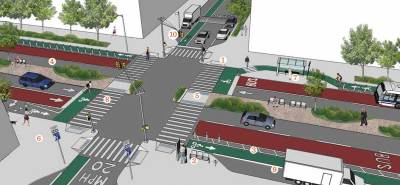DOT Queens Safety Plan Zeroes in on Problems, Light on Specific Fixes

DOT is releasing a Vision Zero pedestrian safety plan for each borough. The first one was unveiled Monday in Jamaica, and a Manhattan event is underway this morning. The Queens report is a detailed analysis of where motorists are doing the most harm, and it provides a general strategy to prioritize street redesigns and traffic enforcement. But it also makes clear that the pace of planned engineering improvements is nowhere near what is needed to achieve the street safety gains sought under the Vision Zero program.
Queens has the second-highest per capita pedestrian fatality rate in the five boroughs, after Manhattan, according to DOT. Though down by nearly 50 percent since the 1980s, fatalities have spiked in recent years. The majority of pedestrian and cyclist deaths and serious injuries occur in the same clusters of neighborhoods, streets, and intersections.
The 50-page borough action plan [PDF] analyzes the life-threatening conditions faced every day by people who walk in Queens and catalogues the most dangerous locations. Topline findings include:
- Wide roads known as “arterials” comprise just 11 percent of Queens’ total street network but account for 61 percent of pedestrian fatalities.
- The 47 “priority corridors” identified by DOT make up 6 percent of the borough’s street network but account for 51 percent of crashes resulting in death or serious injury.
- Driver behavior is a primary or contributing cause in 75 percent of pedestrian deaths that occur on priority corridors.
- The 72 “priority intersections” identified by DOT make up a tiny fraction of the borough’s 18,150 intersections but account for 15 percent of serious crashes.
- Half of all serious pedestrian injuries and deaths occur in 17 square miles that DOT targets as “priority areas.”
- Crashes resulting in serious injury and death are mostly concentrated “in and around the early towns and villages of Queens County,” including Jamaica, Flushing, and Elmhurst, and often happen near elevated train tracks.
- Seniors make up 13 percent of Queens’ population but account for 35 percent of pedestrian deaths.
The analysis of the problem is top-notch, but the report provides few specifics about DOT’s proposed solutions. DOT says Queens will benefit from “at least 50 Vision Zero safety engineering improvements” and the five miles of protected bike lanes to be implemented annually citywide, but doesn’t identify where those improvements will be this year.
Instead, the reports sticks to general strategies. DOT plans to add leading pedestrian intervals on priority corridors and at “feasible” intersections by the end of 2017, and will alter signal timing to “reduce off-peak speeding” as deemed “feasible.” Lighting will be augmented under elevated trains at some transit stops, and new speed limit signs installed. Locations identified in the report will receive focused traffic enforcement from speed cameras and NYPD, according to the report.
The pace of improvement isn’t rapid enough, either, with 10 to 12 safety projects planned for Queens in 2015. The scale of each project can vary widely, from an entire street to a single intersection.
To achieve the city’s goal of eliminating traffic deaths by 2024, “it’s going to become more and more important that we’re tackling in haste the most dangerous locations,” says Caroline Samponaro, deputy director of Transportation Alternatives. “The report is really good in that it does call attention to those, but I think it does lead to the question of, ‘Do we have the resources we need right now to look at Queens Boulevard and tackle it from beginning to end?’ Not to mention the dozens of other top priority crash locations.”
Samponaro says the Queens analysis shows DOT will have to increase the number of projects it does per year, and that the agency needs to count each dangerous street as a single project, not a collection of smaller ones.
“It seems that we’ve built consensus around the idea that we have to start around arterials,” she says, “but I think the thing that we haven’t built consensus around yet is that the number of projects and the amount of resources being brought to those projects, in the short- and near-term, needs to be much bigger. That’s the bottom line.”
